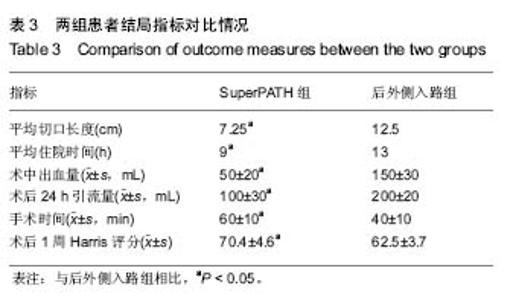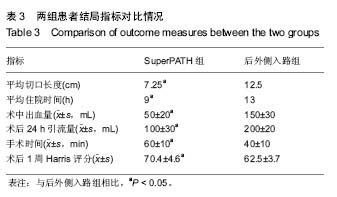| [1] Liu M, Yang J, Yu X, et al. The role of perioperative oral nutritional supplementation in elderly patients after hip surgery. Clin Interv Aging. 2015;10:849-858.[2] Taraldsen K, Thingstad P, Sletvold O, et al. The long-term effect of being treated in a geriatric ward compared to an orthopaedic ward on six measures of free-living physical behavior 4 and 12 months after a hip fracture-a randomised controlled trial. BMC Geriatr. 2015;15:160. [3] Tsertsvadze A, Grove A, Freeman K, et al. Total hip replacement for the treatment of end stage arthritis of the hip: a systematic review and meta-analysis. PLoS One. 2014; 9(7):e99804.[4] Kawaji H, Uematsu T, Hoshikawa N, et al. Mid-Term Clinical Results of VerSys Hip System (Zimmer) Uncemented Total Hip Replacement Arthroplasty. J Nippon Med Sch. 2016; 83(5):184-187.[5] Yi J, Han KY, Nam YJ, et al. Result of Modular Necks in Primary Total Hip Arthroplasty with a Average Follow-up of Four Years. Hip Pelvis. 2016;28(3):142-147.[6] Shah SB, Manson TT, Nascone JW, et al. Radiographic Determinants of Early Failure After Posterior Wall Acetabular Fracture Fixation. Orthopedics. 2016; 39(6):e1104-e1111. [7] Zhang ZF, Min JK, Zhong JM, et al. Distal fixation prosthesis for unstable intertrochanteric fractures in elderly patients: a mid-term follow-up study. Zhongguo Gu Shang. 2016;29(6): 491-495. [8] Schäffler A, Freude T, Stuby F, et al. Surgical Treatment of Acetabulum Fractures with a New Acetabulum Butterfly Plate. Z Orthop Unfall. 2016;154:488-492. [9] 赵建,刘少平,林波.微创髋关节置换术与传统髋关节置换术疗效及对患者生活质量影响的对比研究[J].临床和实验医学杂志, 2015, 14(9):750-753.[10] Bodrogi AW, Sciortino R, Fitch DA, et al. Use of the supercapsular percutaneously assisted total hip approach for femoral neck fractures: surgical technique and case series. J Orthop Surg Res. 2016;11(1):113.[11] 黄钢勇,夏军,魏亦兵,等.Super PATH入路髋关节置换术治疗高龄老年股骨颈骨折短期临床疗效[J].国际骨科学杂志,2016, 37(5):331-336.[12] 何启新,乔巨峰,刘永青.SuperPath微创人工全髋关节置换术与常规全髋关节置换术早期疗效比较[J].广东医学院学报,2016, 34(3):289-292.[13] Frandsen PA, Andersen E, Madsen F, et al. Garden's classification of femoral neck fractures. An assessment of inter-observer variation. J Bone Joint Surg Br. 1988;70(4): 588-590.[14] Cao JG, Wang L, Liu J. The use of clamped drainage to reduce blood loss in total hip arthroplasty. J Orthop Surg Res.2015;10:130.[15] 胡方煜,赖仁欢,梁木荣,等.SuperPATH入路微创人工全髋关节置换术的临床应用[J].微创医学,2016,11(3):416-418.[16] 陶妍志.髋关节置换术围手术期护理及康复护理研究[J].护士进修杂志,2015,30(14):1280-1282. [17] Qurashi S, Chinnappa J, Lord SJ, et al. Driving After Microinvasive Total Hip Arthroplasty. J Arthroplasty. 2016. doi: 10.1016/j.arth.2016.11.052.[18] Chow J, Fitch DA. In-hospital costs for total hip replacement performed using the supercapsular percutaneously-assisted total hip replacement surgical technique. Int Orthop. 2016.[19] Bodrogi AW, Sciortino R, Fitch DA, et al. Use of the supercapsular percutaneously assisted total hip approach for femoral neck fractures: surgical technique and case series. J Orthop Surg Res. 2016;11(1):113.[20] Cardenas-Nylander C, Bellotti V, et al. Innovative approach in total hip arthroplasty: supercapsular percutaneously-assisted. Hip Int. 2016;26 Suppl 1:34-37. [21] Cronin MD, Gofton W, Erwin L, et al. Early surgical and functional outcomes comparison of the supercapsular percutaneously-assisted total hip and traditional posterior surgical techniques for total hip arthroplasty: protocol for a randomized, controlled study. Ann Transl Med. 2015;3(21): 335. [22] Della Torre PK, Fitch DA, Chow JC. Supercapsular percutaneously-assisted total hip arthroplasty: radiographic outcomes and surgical technique. Ann Transl Med. 2015; 3(13):180. [23] Rasuli KJ, Gofton W. Percutaneously assisted total hip (PATH) and Supercapsular percutaneously assisted total hip (SuperPATH) arthroplasty: learning curves and early outcomes. Ann Transl Med. 2015;3(13):179. [24] Gofton W, Fitch DA. In-hospital cost comparison between the standard lateral and supercapsular percutaneously-assisted total hip surgical techniques for total hip replacement. Int Orthop. 2016;40(3):481-485. [25] Belinky F, Nativ N, Stelzer G, et al. PathCards: multi-source consolidation of human biological pathways. Database (Oxford). 2015 Feb 27;2015. pii: bav006. [26] Gofton W, Chow J, Olsen KD, et al. Thirty-day readmission rate and discharge status following total hip arthroplasty using the supercapsular percutaneously-assisted total hip surgical technique. Int Orthop. 2015;39(5):847-851. [27] Xu B, Gao J, Li C. An efficient algorithm for DNA fragment assembly in MapReduce. Biochem Biophys Res Commun. 2012;426(3):395-398. [28] Chow J, Penenberg B, Murphy S. Modified micro-superior percutaneously-assisted total hip: early experiences case reports. Curr Rev Musculoskelet Med. 2011;4(3):146-150. [29] Pevzner PA, Tang H. Fragment assembly with double-barreled data. Bioinformatics. 2001;17 Suppl 1: S225-S233. |

